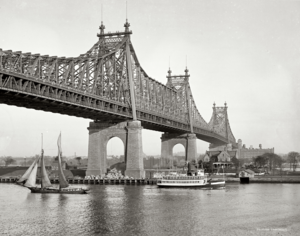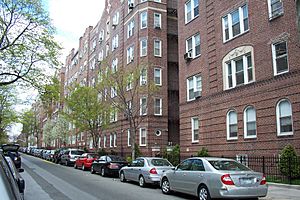Queensboro Corporation facts for kids
| Industry | Housing |
|---|---|
| Founded | Queens, New York, United States (August 12, 1909) |
| Founder | Edward A. MacDougall |
| Headquarters |
Queens, New York
,
United States
|
The Queensboro Corporation was a company that bought and sold land. It was started by Edward A. MacDougall. This company was very important in building up the Jackson Heights neighborhood in Queens, New York City.
Contents
How Jackson Heights Began

The Queensboro Corporation was created by a group of investors from New York. Edward A. MacDougall led this group. The company started on August 12, 1909. Its goal was to develop an area then called Trains Meadow.
The company bought its first 128 acres (52 ha) of land in 1910. By 1914, it owned about 350 acres (140 ha). MacDougall renamed the area Jackson Heights. He named it after Jackson Avenue, which was a main road. The word "Heights" was added to make the area sound fancy.
At first, it was easiest to reach the area by ferry from Manhattan. But the Queensboro Bridge opened in 1909. This made Jackson Heights much easier to get to.
Building a New Community
The Queensboro Corporation worked hard to develop the land. They did more than just build houses. They planned the entire community. This included dividing the land into blocks and lots. They also put in streets, sidewalks, power, water, and sewers.
By 1912, 8 miles (13 km) of paved roads were built. These roads had sidewalks and curbs. There were also 5 miles (8.0 km) of sewers. In 1917, the elevated IRT Flushing Line subway reached Jackson Heights. This cut travel time to Manhattan to just twenty minutes. There were four subway stations in Jackson Heights. These were at 74th Street, 82nd Street, Elmhurst Avenue, and Junction Boulevard.
In 1922, the Queensboro Corporation encouraged the Fifth Avenue Coach Company. This company started a direct bus service to Jackson Heights. They used double-decker buses.
Who Lived There?
The Queensboro Corporation wanted to attract middle-class people from New York. These were people who could afford to live in the suburbs. In 1914, the company's directors visited new housing areas in Europe. They likely saw "garden apartment" projects in Berlin. These projects were built between 1904 and 1909.
Instead of single-family houses, the Queensboro Corporation decided to build fancy apartment buildings. These buildings had shared garden spaces. The apartments were high quality. They had nice exteriors and features like fireplaces and wood floors. They also had sun rooms and built-in bathtubs.
The apartments were sold, not rented. This was first called a "collective ownership plan." Later, it was changed to "cooperative ownership." This new name sounded better.
For many years, the Queensboro Corporation and the Jackson Heights community worked closely. The local newspaper often shared the company's views. The company helped develop the shopping area near the 82nd Street subway station. It also helped set up a community board. This board helped civic groups grow. MacDougall even gave land for churches.
In the early years, the company had a policy. It carefully chose who could live in the apartments. This was to bring together people with similar ideas and ways of living. This policy changed after the Great Depression in the 1930s.
Garden Apartments and New Ideas
The Laurel apartment building was the first Queensboro Corporation building in Jackson Heights. It was finished in 1914. This building had a small courtyard. The Greystones were finished in 1918. The architect George H. Wells designed them. The Queensboro Corporation called these "garden apartments." This name showed that the apartments were surrounded by green spaces.
There was a lot of unused land. This land was turned into parks and gardens. Some areas were used for fun activities, like a golf course. These green spaces were used to attract buyers. Later, much of this land was built on. In 1919, the company started offering "cooperative ownership." This helped create a stronger sense of community.
Early Advertising
On August 28, 1922, the Queensboro Corporation paid the WEAF radio station $50. They broadcast a ten-minute sales talk for apartments in Jackson Heights. This might have been the first "infomercial" (a long advertisement). It started by talking about Nathaniel Hawthorne. Then it promoted the company's Nathaniel Hawthorne apartments.
Mr. Blackwell from the Queensboro Corporation told listeners:
seek the recreation and the daily comfort of the home removed from the congested part of the city, right at the boundaries of God's great outdoors, and within a few minutes by subway from the business section of Manhattan ... The cry of the heart is for more living room, more chance to unfold, more opportunity to get near Mother Earth, to play, to romp, to plant and to dig ... Let me enjoin upon you as you value your health and your hopes and your home happiness, get away from the solid masses of brick ... where your children grow up starved for a run over a patch of grass and the sight of a tree...
Famous Architects and Designs
The Queensboro Corporation hired a well-known architect named Andrew J. Thomas. He was a big supporter of garden apartments. Thomas did some of his most important work for the company.
One example was the Linden Court complex. It was built between 84th and 85th Streets and 37th and Roosevelt Avenues. The buildings were in pairs around a shared open garden. There were gaps in the walls. This design let in light and air. It also made people feel like they belonged to a community. Linden Court was the first development to have parking spaces. It had small garages with narrow driveways.
Thomas also designed the Château and Towers projects. These were for people with higher incomes. Both were on 34th Avenue and sold as cooperatives. They had large, airy apartments and elevators. The beautiful Château complex was built in a French Renaissance style. Its twelve buildings surrounded a large garden. They had slanted roofs and brick walls.
At first, the gardens were just for looking at. As garden apartments became more popular, the gardens grew larger. They started to include paved areas where people could meet or sit. In 1924, the Queensboro Corporation began the Ivy Court, Cedar Court, and Spanish Gardens projects. Thomas designed all of these.
Later Years and Changes
In the mid-1920s, the Queensboro Corporation also built single-family homes. These were attached or semi-detached. They had brick fronts in American Colonial or English Tudor styles.
After the Wall Street Crash of 1929, the country faced a ten-year economic downturn called the Depression. The company tried to manage its business better. It also tried to let private groups take over maintaining things like roads. Fancy apartment buildings that were once only for certain people were opened to those with lower incomes. Apartments were divided into smaller units, and rooms were rented out. Jackson Heights lost its very exclusive feel.
Property values dropped a lot in the early 1930s. The Queensboro Corporation had money problems. To get money, the company started building on land that was once open for the community. This included the golf course, tennis courts, and community garden. The company also started building typical six-story apartment buildings.
Dunolly Gardens was the last garden apartment complex Thomas built. It was a modern building finished in 1939. Its corner windows were very new for the 1930s. They made the apartments feel more spacious.
Edward A. MacDougall passed away in 1944. His son, A.E. MacDougall, became the new president. In September 1944, he wrote in the Jackson Heights News: "As soon as [wartime] restrictions are lifted by the Government, Jackson Heights will be ready to provide the most attractive types of garden apartments in close proximity to the center of Manhattan."
In 1947, the New York City Housing Authority wanted to build public housing in Jackson Heights. But the local residents did not agree with the idea. In the 1940s, the Queensboro Corporation sold much of its land to other builders.
The Queensboro Corporation finished the Carlton House in 1947. They tried to sell the apartments as cooperatives. But not many people wanted to buy them. So, the company started renting the apartments instead. In 1949, the company launched the Greenbrier. This was the last cooperative the Queensboro Corporation sold in Jackson Heights.



